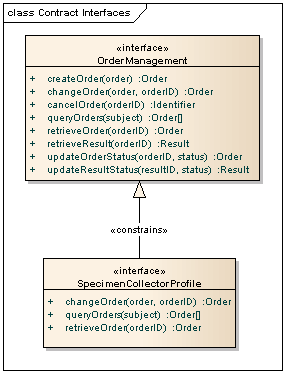This wiki has undergone a migration to Confluence found Here
Difference between revisions of "Order Request Manager Conceptual Specification"
Jump to navigation
Jump to search
| Line 197: | Line 197: | ||
=Recommendations for Conformance and Compliance= | =Recommendations for Conformance and Compliance= | ||
| + | |||
| + | These will be elaborated in the next round of specification development | ||
Revision as of 04:50, 26 November 2012
Link back to solution specification
Contents
Overview
Service Description and Purpose
The purpose of the order request manager is that of a service which can analyze the results returned from the fulfiller and determine when the request has been fulfilled from an ordering perspective.
Scope
Comment
Describe the overall potential scope of the service. Are any items being specifically excluded from the scope? Why?
Reason why the service is necessary
Comment
Rationale for creating this specification. Consumer viewpoint and the value offered by the work product
Links to Use Cases/ Storyboards
- (optional, depending on detail in interop business scenario section
Structure of the Service
The Order Manager Conceptual Diagram is shown below. A separate functional profile is defined for organizations that need only specimen collection operations (for instance, third party specimen collectors).
Organization
Comment Elaborate any logical groupings that emerge from the usage scenarios
Assumptions and Dependencies
Comment Upon what services does this specification depend (underpinning infrastructure, other HL7 services, etc. Are there any key assumptions that are being made?
Implementation Considerations
Comment
Relevant and representative examples of deployment scenarios. Consider representation formalism and the intended audience, not necessarily rigorously expressing the content in UML. This specification in the real world (e.g., relationships to existing infrastructure, other deployed services, dependencies, etc.). Consider the ways that information bindings will be realized through the operations. If necessary, outline a strategy for this binding.
Detailed Functional Model for Each Operation
Create Order
- Description: Allows the client to create an order for a service
- Pre-Conditions:
- The client has sufficient information to create the request
- User or requestor has permissions to create a request within the context
- Conceptual Information Objects
- Inputs: Order
- Outputs: Order
- Post-Conditions: The returned order structure has been updated with order identifier
- Exception Conditions: None identified
- Aspects left for Technical Bindings (optional)
- Reference to Functional Profiles (optional)
- Notes
Change Order
- Description: Allows the client to submit a change to an existing Order.
- Pre-Conditions:
- An order exists and the identifier is known
- The order is not completed
- The user or requestor has permission to update an order
- Conceptual Information Objects
- Inputs: Order, Order Identifier
- Outputs: Order, Promise
- Post-Conditions:
- The order referenced by order identifier has been updated to match the requirements in the input order
- The modified order is returned
- Exception Conditions:
- Order is not known to the fulfiller
- Order has already been completed
- Aspects left for Technical Bindings (optional)
- Reference to Functional Profiles (optional)
- Notes
Cancel Order
- Description: Used when a requestor (placer) would like for a previously requested, and not yet completed, order to not be performed.
- Pre-Conditions:
- An order exists and the identifier is known
- The order is not completed
- The user or requestor has permission to update an order
- Conceptual Information Objects
- Inputs: Order, Order Identifier
- Outputs: Order
- Post-Conditions:
- The order referenced by order identifier has been cancelled and will not be acted upon.
- The cancel order is returned
- Exception Conditions:
- Order is not known to the fulfiller
- Order has already been completed
Query Orders
- Description: Used to obtain a list of Orders relevant to a specific Subject.
- Pre-Conditions:
- Conceptual Information Objects
- Inputs: Subject
- Outputs: a list of Orders
- Post-Conditions
- Exception Conditions
- Aspects left for Technical Bindings (optional)
- Reference to Functional Profiles (optional)
- Notes:
- At the logical level, addition query criteria (eg date ranges, result status, etc) may be defined
Retrieve Order
- Description: Allows the client to retrieve a specific Order, given an order identifier
- Pre-Conditions:
- The order identifier is known
- The client has permission to retrieve orders
- Conceptual Information Objects
- Inputs: Order Identifier
- Outputs: Order
- Post-Conditions
- Exception Conditions
- Aspects left for Technical Bindings (optional)
- Reference to Functional Profiles (optional)
- Notes
Update Order Status
- Description: Allows the client to identify a change in status of the order (e.g. update the status to 'specimen collected')
- Pre-Conditions:
- Conceptual Information Objects
- Inputs: Order Identifier, Status
- Outputs: Order
- Post-Conditions: The order status has been changed to the new value
- Exception Conditions: The order identifier cannot be found.
The status change request is an invalid state transition
- Aspects left for Technical Bindings (optional)
- Reference to Functional Profiles (optional)
- Notes
Update Result Status
- Description: Allows the fulfiller (or performer) of the order (whom is also the author of the result) to change the status of the result.
- Pre-Conditions:
- Result must already exist
- Conceptual Information Objects
- Inputs: Result, Result Identifier
- Outputs: Result
- Post-Conditions
- Result updated with new status
- Exception Conditions: Order does not previously exist
- Aspects left for Technical Bindings (optional)
- Reference to Functional Profiles (optional)
- Notes
Profiles
Introduction
Functional Profiles
Information Profiles
Comment
- describe any information profiles applicable to this service, and the related state transitions
Recommendations for Conformance and Compliance
These will be elaborated in the next round of specification development
